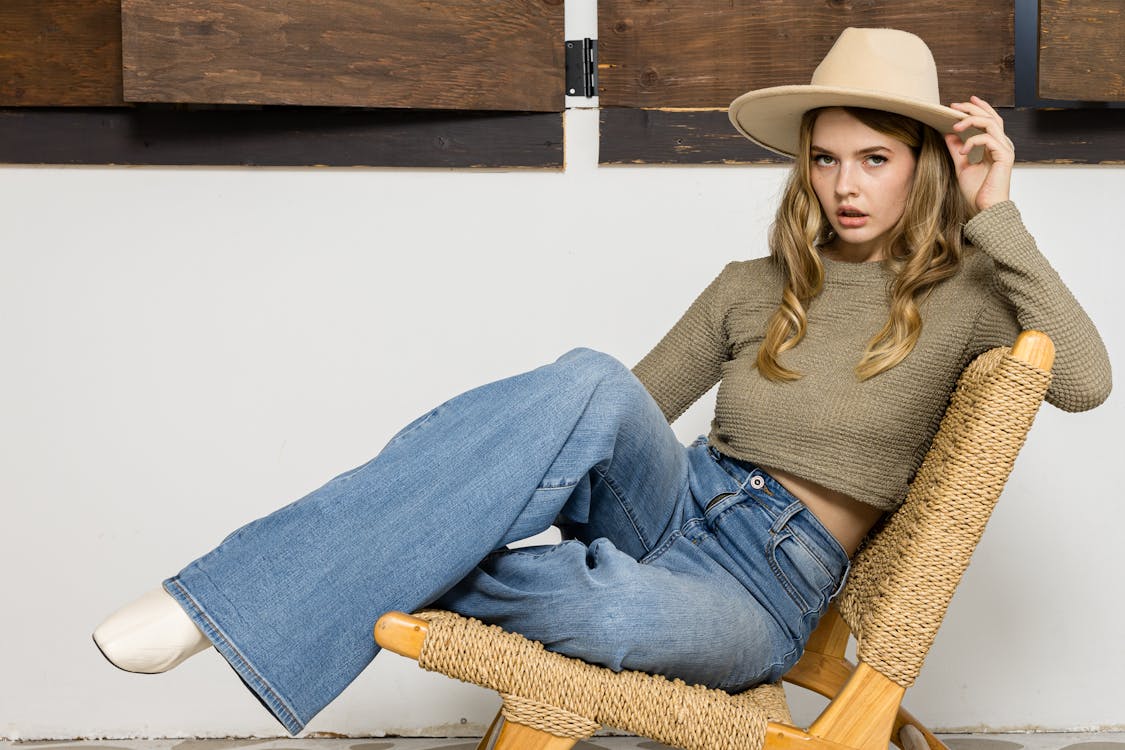Di MODENLY, kami memberikan perhatian besar pada denim. Sebagai produsen pakaian B2B terkemuka, kami mengkhususkan diri dalam membuat jeans khusus premium untuk merek, toko, dan perusahaan mode yang berusaha menyediakan denim yang khas dan dibuat dengan baik. Tujuan kami adalah memberikan harga grosir yang terjangkau sekaligus memberikan jeans premium yang dipesan lebih dahulu yang memadukan kenyamanan, gaya, dan pengerjaan.
Namun, pernahkah Anda mempertimbangkan apa yang dilakukan untuk menciptakan celana jeans yang ideal? Denim adalah kombinasi dari pengerjaan, teknologi, dan perhatian yang cermat terhadap detail-bukan hanya kain. Setiap celana melalui prosedur yang melelahkan mulai dari sketsa pertama hingga jahitan terakhir untuk menjamin kesesuaian yang sempurna, daya tahan seumur hidup, dan penampilan yang mudah dikenali. Artikel ini akan membawa Anda ke balik layar pembuatan jeans khusus. Apakah bisnis Anda adalah merek butik, toko fashion, atau hanya seseorang yang terpesona oleh seni denim, analisis mendalam ini akan membantu Anda untuk menghargai sektor jeans yang dipesan lebih dahulu.

Langkah 2: Bahan Kain - Memilih Denim yang Tepat
Kualitas jeans khusus dimulai dengan memilih kain yang tepat. Denim memiliki berat, tekstur, dan komposisi yang bervariasi dalam hal rasa dan tingkat daya tahan.
Jenis Denim yang Digunakan pada Jeans Kustom
- Raw Denim: Denim kaku yang tidak dirawat dan memudar serta membentuk sesuai bentuk pemakainya seiring berjalannya waktu. Sempurna untuk merek yang melayani para penggemar denim.
- Stretch Denim: Dicampur dengan spandeks atau elastane untuk menambah kenyamanan dan fleksibilitas, ideal untuk skinny jeans dan gaya yang pas di badan.
- Denim yang Berkelanjutan: Kapas organik, denim daur ulang, atau kain yang menggunakan teknik pewarnaan hemat air, memenuhi permintaan yang terus meningkat akan fesyen ramah lingkungan.
Di luar komposisi kain, komposisi berat denim juga penting. Denim ringan (8-12 oz) lembut dan bernapas, cocok untuk iklim yang lebih hangat, sementara denim kelas berat (14-21 oz) tahan lama, terstruktur, dan ideal untuk pemakaian yang tahan lama.
Mencari Produsen Pakaian Satu Atap? Dari Desain hingga Pengiriman, Kami Menangani Semuanya!
Langkah 3: Pemotongan Presisi - Ilmu Kesesuaian
Pemotongan denim telah lama menjadi kerajinan yang disempurnakan oleh para seniman berbakat yang dengan susah payah memotong setiap potongan dengan tangan menggunakan templat kertas yang ditandai dengan baik. Diperlukan pengetahuan bertahun-tahun untuk proses ini karena variasi terkecil sekalipun dapat menyebabkan keselarasan jahitan yang salah atau ketidaksesuaian yang buruk, yang mengakibatkan pemborosan produksi atau tingkat pengembalian yang tinggi dari konsumen atau produsen. Meskipun metode kerajinan tangan ini menjamin keakuratan detail, metode ini juga membutuhkan banyak tenaga kerja dan rentan terhadap kesalahan manusia.
Teknologi teknologi modern telah mengubah teknik pemotongan jeans dan menambahkan tingkat akurasi yang belum pernah ada sebelumnya ke dalam operasi. Untuk mencapai akurasi yang nyaris tanpa cela saat ini, produsen modern menggunakan perangkat lunak pembuatan pola digital yang dipadukan dengan perangkat pemotongan yang dipandu laser. Perkembangan ini memungkinkan:
Keseragaman yang sempurna pada beberapa kali proses produksi membantu menurunkan varians kecocokan. Penggunaan bahan yang efektif, pengurangan limbah kain, sehingga produksi lebih berkelanjutan. Kecepatan dan skalabilitas yang lebih tinggi akan membantu produsen untuk mengelola pesanan dalam jumlah besar dengan persyaratan yang tepat. Fitur penyesuaian yang disempurnakan menjamin bahwa jeans yang dibuat sesuai ukuran atau disesuaikan pun tetap memiliki ukuran yang profesional dan disiplin.
Untuk menjaga penampilan yang alami dan modis pada periode ini, elemen desain tambahan termasuk detail berjumbai, keliman mentah, atau robekan lutut diposisikan dengan cermat.
Langkah 4: Penjahitan & Perakitan - Mewujudkan Jeans Kustom Menjadi Nyata
Setelah pemotongan yang tepat, prosedur penjahitan dan perakitan mengubah panel kain datar menjadi garmen yang benar-benar jadi. Pada titik ini, keakuratan desain berpadu dengan daya tahan untuk memastikan setiap celana jeans yang dipersonalisasi dibuat untuk bertahan lama sambil tetap mempertahankan tampilannya yang unik. Memperkuat struktur, meningkatkan kenyamanan, dan mendapatkan kilau halus yang membedakan denim mewah dari denim yang diproduksi secara massal sangat bergantung pada proses penjahitan berkualitas tinggi.
Daya tahan jeans sangat bergantung pada struktur dan penguatan jahitan. Umumnya digunakan pada bagian inseam dan outseam, jahitan ganda menjamin keawetan dalam jangka panjang dan membantu meminimalkan kerutan. Diaplikasikan pada titik-titik dengan tekanan tinggi termasuk loop sabuk, bukaan saku, dan fly seams, bar-tacking-jahitan penguat zig-zag-memperkuat titik-titik sensitif tersebut dari penggunaan rutin. Selain itu, saku yang diperkuat dengan jahitan ekstra atau lapisan kain memberikan ketangguhan yang lebih besar pada jeans, sehingga meningkatkan ketahanannya terhadap keausan.
Konstruksi denim juga sangat bergantung pada pilihan benang. Untuk jeans yang tangguh dan tahan lama, katun poli-inti tugas berat atau benang yang diperkuat Kevlar menawarkan kekuatan yang luar biasa; jahitan jarum tunggal yang lebih halus menghasilkan tampilan yang lebih ramping dan lebih pas untuk desain yang fashion-futuristik. Beberapa produsen menggunakan warna benang yang berbeda atau pola jahitan yang tidak biasa pada saku belakang untuk menciptakan ciri khas yang langsung dapat dikenali, jahitan itu sendiri dapat berfungsi sebagai elemen merek.
Lebih dari sekadar penggunaan, fitur desain seperti patch kulit yang dipersonalisasi, paku keling berukir, dan jahitan hias membantu mendefinisikan sebuah merek. Elemen-elemen kecil namun penting ini tidak hanya menambah tampilan umum jeans, tetapi juga membedakannya dalam industri denim yang ramai. Jahitan yang sangat baik adalah tentang keahlian, branding, dan memberikan produk premium yang membedakannya - tidak hanya tentang umur panjang.
Mempelajari Daya Tahan dan Teknik Jahitan Gaya
Tampilan dan masa pakai jeans sangat bergantung pada jenis benang dan metode jahitan yang dipilih. Jeans buatan tangan yang sangat baik terkadang memiliki:
- Jahitan yang dijahit ganda: Digunakan di sepanjang titik-titik stres seperti keliman dalam, keliman luar, dan kuk belakang, jahitan ganda menjamin integritas jahitan dan meningkatkan kekuatan, sehingga menurunkan kemungkinan kain berjumbai atau terbelah seiring waktu.
- Kantong yang diperkuat: Saku depan dan belakang jeans sering digunakan dan berada di bawah tekanan, oleh karena itu, penguatannya cukup penting. Banyak perusahaan denim kelas atas menggunakan pelapis saku dan metode jahit tugas berat untuk menghentikan robekan.
- Pengikatan batang pada titik-titik stres: Bar-tacking adalah jahitan penguat zig-zag khusus yang diterapkan pada area yang memiliki tekanan tinggi seperti loop sabuk, sudut saku, dan bukaan lalat. Dengan menghentikan robekan jahitan akibat tarikan dan regangan yang berulang-ulang, pendekatan ini sangat memperpanjang usia pakai.
- Pemilihan benang: Estetika desain dan daya tahan dapat sangat dipengaruhi oleh berat dan jenis benang yang digunakan. Benang yang lebih tebal dan berdaya tarik tinggi-kapas poli-inti atau serat yang diperkuat Kevlar-menawarkan kekuatan dan ketahanan abrasi yang luar biasa untuk celana yang tangguh dan berat. Sebaliknya, jahitan jarum tunggal yang lebih baik dapat menciptakan tampilan yang lebih ramping dan lebih halus yang cocok untuk desain denim yang berorientasi pada mode atau yang disesuaikan.

Langkah 5: Mencuci & Menyelesaikan - Sentuhan Akhir
Denim mentah diubah menjadi produk yang dapat dikenakan, modis, dan menyenangkan pada tahap pencucian dan finishing. Metode ini meningkatkan tekstur kain, kelembutan, dan daya tarik visual, sehingga memungkinkan produsen untuk menciptakan desain khas yang mencakup pudar vintage hingga sentuhan akhir yang tajam dan mentah.
Pencucian Batu - Tampilan Klasik yang Sudah Usang
Untuk mendapatkan tampilan lapuk secara alami, pencucian batu melapisi denim dengan batu apung. Hal ini memberikan kesan pudar dan tua pada kain dan melembutkannya. Meskipun efisien, pendekatan ini menggunakan banyak air, oleh karena itu banyak perusahaan memilih pencucian dengan enzim sebagai pengganti yang lebih ramah lingkungan yang memberikan hasil yang sebanding dengan menggunakan enzim yang dapat terurai.
Menyusahkan - Menambahkan Karakter pada Denim
Pengocokan, penggerindaan, dan pemudaran laser adalah beberapa proses yang mengganggu yang meniru pola keausan alami untuk menghasilkan hasil yang kasar dan usang. Perusahaan seperti Diesel dan Levi's menerapkan proses distressing yang tepat untuk menjamin penampilan yang nyata dan kuat. Jumlah distressing yang disesuaikan memungkinkan perusahaan menargetkan berbagai pelanggan, mulai dari jeans premium hingga streetwear.
Finishing Raw Denim - Pilihan Purist yang Tak Lekang oleh Waktu
Jika dibiarkan tanpa perawatan, denim mentah akan mempertahankan teksturnya yang keras dan warna nila yang pekat. Denim ini mengembangkan pola pudar yang khas dan secara bertahap membentuk tubuh pemakainya. Denim mentah adalah spesialisasi perusahaan seperti Iron Heart dan Samurai Jeans, yang menghadirkan tampilan premium dan berubah-ubah bagi para penggemar denim.
Proses finishing menentukan citra sebuah merek, baik melalui denim mentah yang bersih dan disesuaikan atau gaya yang sangat tertekan. Merek-merek mewah lebih memilih pemudaran yang halus, sementara merek-merek streetwear memilih untuk memberikan kesan yang tegas. Memilih teknik finishing yang tepat memastikan jeans tampil menonjol sekaligus mempertahankan daya tahan dan keberlanjutan.
Langkah 6: Kontrol Kualitas & Pengemasan - Pos Pemeriksaan Terakhir
Jeans telah melalui prosedur kontrol kualitas yang menyeluruh untuk menjamin bahwa mereka memenuhi standar merek sebelum dipasarkan. produsen memeriksa:
- Konsistensi kain dan akurasi warna
- Kekuatan jahitan dan daya tahan jahitan
- Fitur ritsleting dan kancing
- Kesesuaian ukuran dan akurasi ukuran
Setelah disahkan, jeans dikemas dengan komponen merek yang unik termasuk label, hang tag, dan kemasan yang ramah lingkungan. Untuk meningkatkan pengalaman membongkar kemasan, beberapa toko memilih kotak bermerek atau tas yang dapat terurai secara alami. Kapasitas jeans khusus untuk memenuhi pasar khusus adalah salah satu manfaat utamanya. Penyesuaian memungkinkan perusahaan untuk memenuhi kebutuhan konsumen tertentu, baik untuk desain yang terinspirasi dari desain vintage untuk para trendsetter, jeans stretch-fit untuk kehidupan yang aktif, atau denim yang ramah lingkungan untuk konsumen yang sadar lingkungan. Di saat konsumen melakukan pembelian yang lebih cermat dan mengutamakan kualitas daripada kuantitas, hal ini menjadi sangat penting.
Siap Membawa Merek Anda Mendunia? Kami Menawarkan Pengiriman Internasional dan Logistik Tanpa Batas!
Kisah Sukses Dunia Nyata: Bangkitnya Merek Denim Khusus
E** Denim, sebuah perusahaan berbasis di A.S. yang beralih dari menjual denim generik menjadi menyediakan celana yang dibuat khusus dan bersumber dari sumber yang etis, merupakan ilustrasi yang sangat baik tentang bagaimana jeans khusus dapat meningkatkan sebuah merek. E** pertama kali bertarung di pasar yang sudah jenuh, dengan jeans produksi massal yang terlihat persis seperti yang ditawarkan oleh department store. Retensi konsumen mereka buruk dan penjualan mereka datar.
Untuk membedakan dirinya, perusahaan ini mulai menjual jeans dengan ukuran khusus sehingga konsumen dapat memilih tingkat kelonggaran, tingkat pencucian, dan tingkat kelenturan favorit mereka. Mereka juga menyertakan bahan yang berkelanjutan seperti katun organik dan metode pewarnaan yang hemat air. Melalui pemasaran media sosial dan kisah merek yang kuat yang berfokus pada "Denim yang Dirancang untuk Anda", E** mengalami peningkatan penjualan sebesar 300% dalam waktu 12 bulan. Klien mereka menyukai kesesuaian, kenyamanan, dan keunikan, sehingga tingkat pelanggan tetap mereka melonjak tinggi dan mereka dapat menaikkan harga tanpa kehilangan bisnis.
Kesimpulan: Mewujudkan Visi Jeans Kustom Anda Menjadi Nyata
Membuat jeans khusus menggabungkan kreativitas, teknologi, dan pengerjaan yang berpengalaman untuk menciptakan proses yang rumit namun bermanfaat. Mulai dari pemilihan kain dan pemotongan yang tepat hingga penjahitan, finishing, dan branding, setiap tahap berkontribusi untuk menjamin produk akhir yang premium.
Sekarang adalah waktunya bagi perusahaan fesyen, distributor, dan toko untuk melakukan investasi pada jeans khusus. Merek yang menyediakan denim yang mudah beradaptasi dan dibuat dengan baik akan tetap menjadi yang terdepan dalam tren pasar seiring dengan meningkatnya permintaan konsumen akan pakaian yang disesuaikan dan proses yang berkelanjutan. Baik itu lini denim yang sepenuhnya disesuaikan atau koleksi label pribadi, perusahaan yang merangkul penyesuaian harus mengharapkan profitabilitas yang lebih baik, lebih banyak loyalitas konsumen, dan pengakuan merek yang lebih kuat.
Di MODENLY, kami membantu perusahaan dan toko dalam mengembangkan denim premium yang disesuaikan dengan kebutuhan dan menjadi pembeda di pasaran. Apakah tujuan Anda adalah mengembangkan lini pakaian Anda saat ini atau membuat koleksi jeans yang khas, kami menyediakan harga massal, pilihan yang dapat disesuaikan, dan pengerjaan yang profesional untuk mewujudkan visi Anda.

